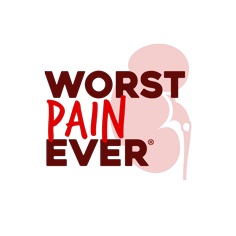For most patients, stents are awful and cause horrible, excruciating pain. Whether you feel uncomfortable, or just plain miserable, there’s lots to learn about stents. We sat down with Dr. Kymora Scotland, PhD from UCLA Health, to give us some insight on reasons why stents hurt and how our urologists make decisions on stents.
Stent pain seems just as awful as stone pain. What is happening and why so?
A small percentage of patients do just fine with a stent. They’re back at work the next day and life is good, but many do not have that experience. Most patients will have at the very least, some discomfort with a stent. A reasonable percentage of people will have a horrible time, up to and including the stent being even worse than the stone.
For decades, urologists have tried to figure out why stents cause so much pain. Initially, people thought it was because of the type of material used to make the stent. A lot of experiments done to make stents with different materials had disproved this. People also thought it was because of the length of the stent but that wasn’t the case either.
Some data suggests that it may be because stents cause reflux, so when the stent is inserted into the bladder, urine in the bladder can sometimes move back up to the kidney.
One finding is that when a stent is put in, instead of helping the ureter to spasm and move things through, it can sometimes cause the ureter to stop contracting. This results in some pooling of urine in the kidney (known as aperistalsis) and it may play a role in causing pain.
That said, we don’t fully know why it is that stents cause pain. What we do know is that there are some things that can help to alleviate the pain, so we give those medications to patients.
You mention that sometimes a stent may be necessary. What factors go into the decision of placing a stent?
There are a couple of situations when I think a stent should be put in. If a patient comes in having a lot of pain, nausea, vomiting and fever from trying to pass a stone and it cannot be controlled with medication, it becomes an emergency and we will need to then drain the kidney and place a stent.
For patients having surgery, we generally will place a stent if the ureter looks a little inflamed. If a stent isn’t inserted, what can happen is that the ureter may swell up and the patient ends up being in just as much pain as before, because their kidney is still blocked. That’s a situation where it’s not safe to not leave a stent because the inflammation may cause obstruction.
I must admit that a lot of urologists will leave stents in place as a preventative measure, because we hear about the kind of pain patients can have after surgery. Leaving a stent in place helps to make sure that the kidney is being drained and the patient is safe from obstruction.
Unfortunately, the decision of placing a stent is dependent on what happens in the operating room. I try my best not to leave a stent but if it feels unsafe to do so, I will have to put one in.
Some share that a stent feels like a mile long! How do doctors determine which stent size to choose?
There were a couple of experiments done where stents of different sizes (thickness and width) were placed in patients to see if they had any less pain. What they found, was that it didn’t make much of a difference.
Most urologists will put stents that are about 6-French (approx. 10 inches long). The only reason most urologists will place a stent that’s bigger than 6-French, is if the patient has another issue. For example, patients may have a ureter that is closed off, making it impossible for us to use our instruments. Placing a large stent will help dilate the ureter so that we can try, at a later time, to treat the stone by going through the ureter. Unfortunately, using small paediatric stents does not seem to make a difference, in terms of the pain experienced.
It can be distressing for people with kidney stones to suffer as they pass their stone(s) and deal with the pain of a stent right after. Can patients request not to have a stent put in?
Yes, and a lot of my patients will do that. I’ve never had stones, but from all these years of taking care of patients, I think I have a good sense of how painful these stents are. I don’t place a stent unless I know my patient really needs it or if I’m really concerned that they will end up in pain if I don’t leave it in.
What you can do is have a conversation with your urologist to make sure that they understand your situation, feelings and experience with stents and come up with a plan together. Most urologists will try to work with you. It’s your body and you have a right to talk about the things that you would like to have done, so don’t be shy to speak up.
Dr. Kymora Scotland is an endourologist practitioner and an Assistant Professor of Urology in UCLA. She also holds the role as Director of Endourology Research and Associate Director of Endourology Fellowship Program.
Dr. Kymora is passionate about her patients and works with them to treat kidney stones and other surgical issues through minimally invasive surgery. She is also a researcher and her clinical expertise are in the treatment of kidney stones and benign prostatic hyperplasia management.





